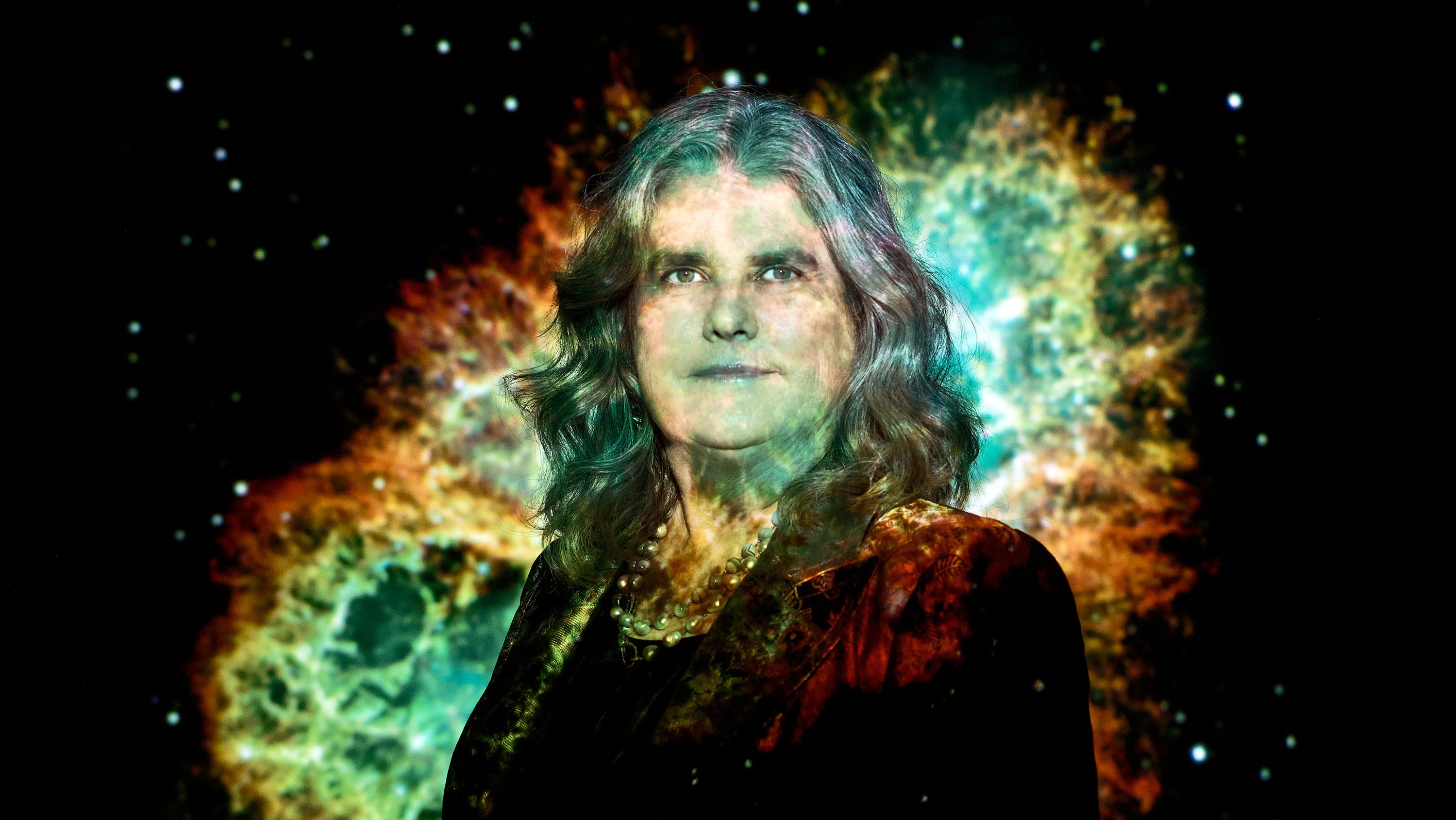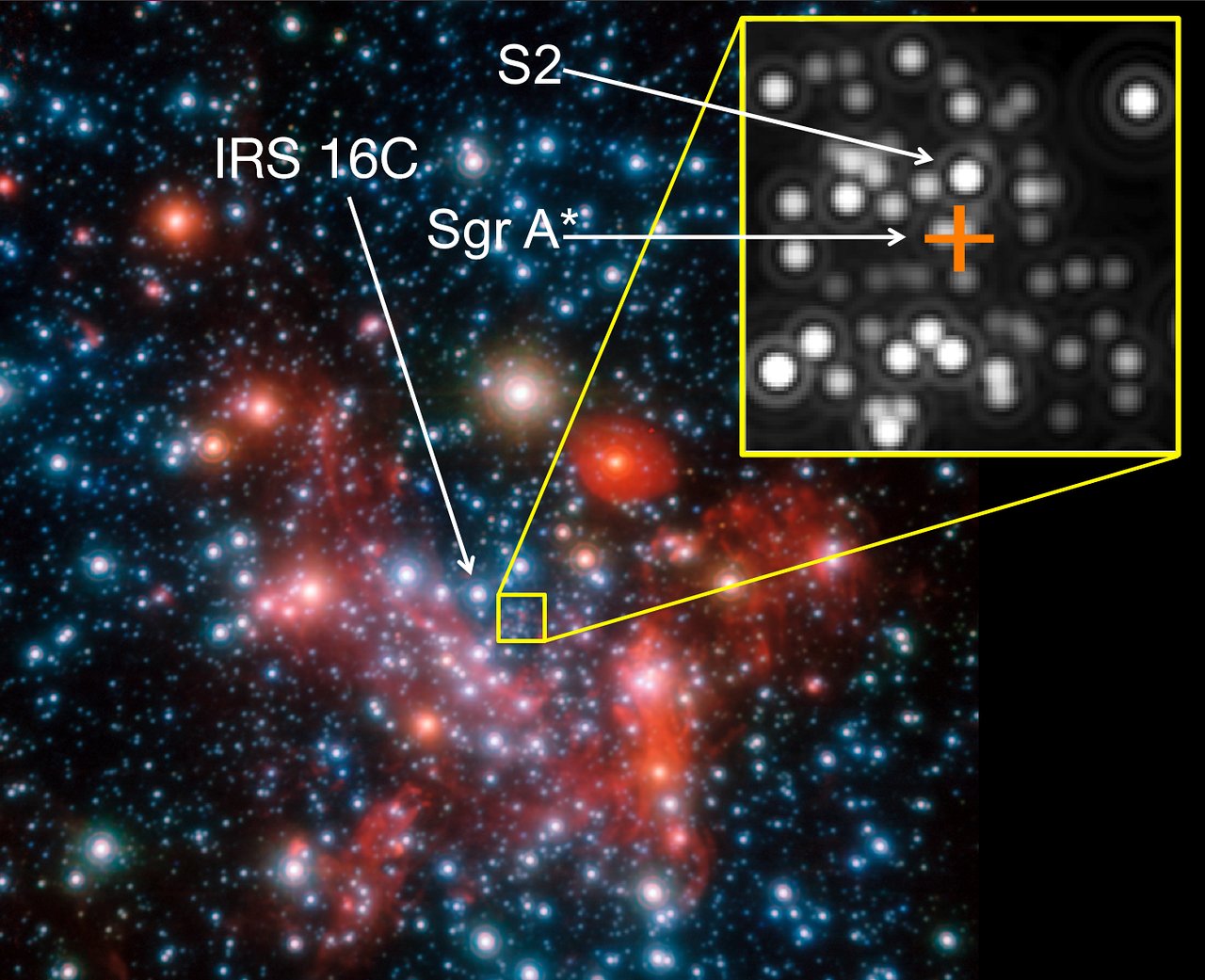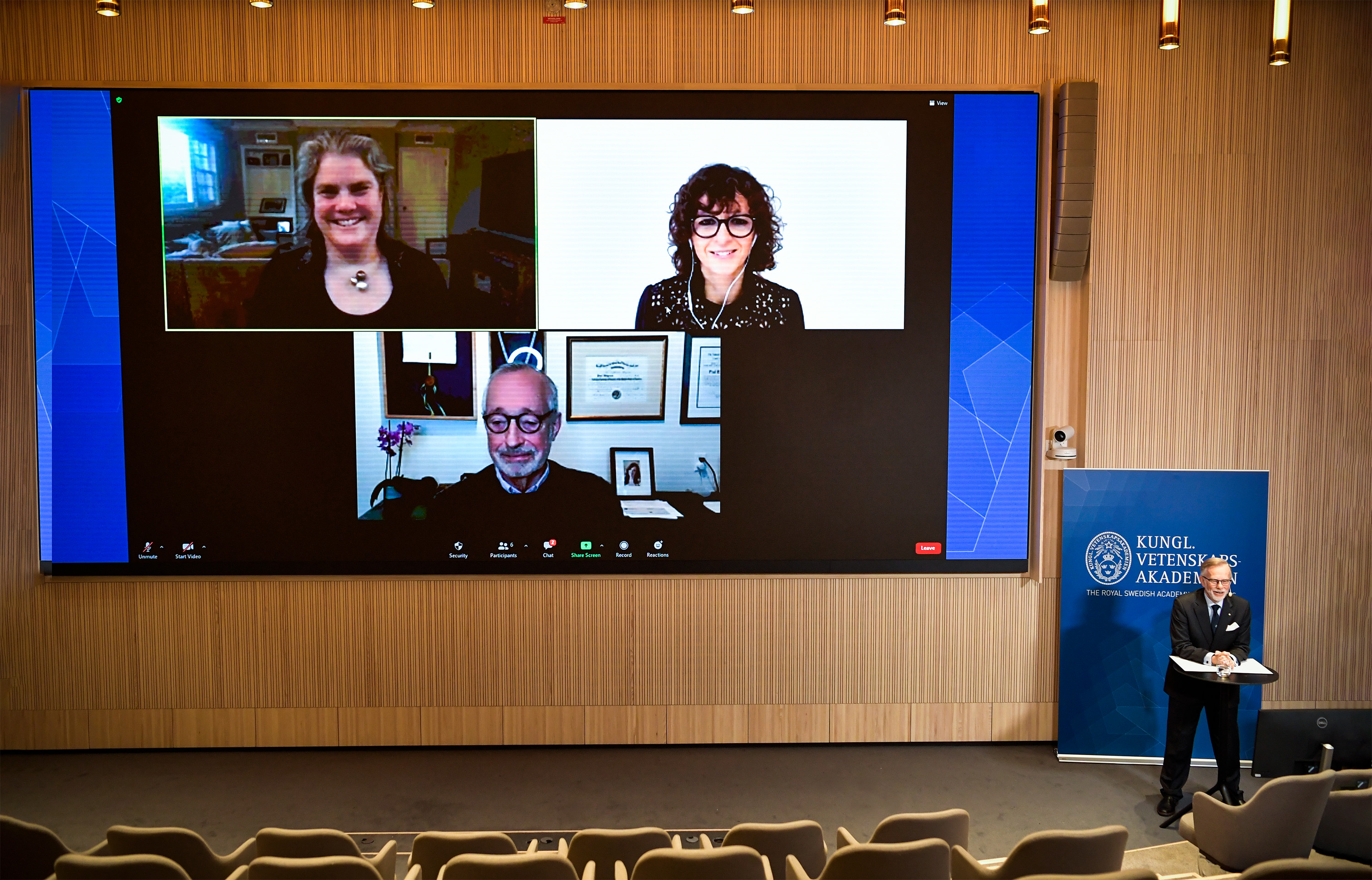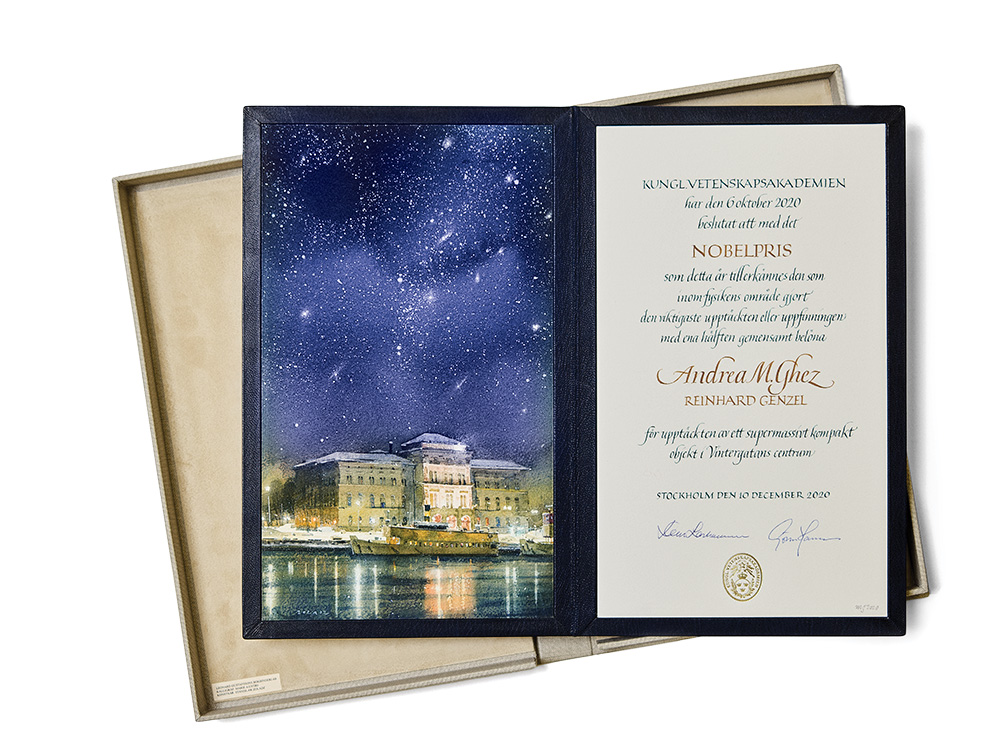Skywatcher
An avid reader of detective novels, Andrea Ghez ’87 turned galactic sleuth to expose the supermassive black hole at the center of the Milky Way.

When astrophysicist Andrea Ghez ’87 was a young girl growing up in Chicago, her father gave her a biography of Marie Curie, and the lesson she drew from it was that a woman could be a great scientist, have children, and win a Nobel Prize. By now, Ghez has done all three, and she shows no signs of slowing down.
Ghez shared the Nobel Prize in physics in 2020 for 25 years of research that confirms the existence of a supermassive black hole at the center of the Milky Way galaxy. She is only the fourth woman to receive the prize for physics.
The work took decades, during which technology and instruments changed, grad students came and went, and massive amounts of data were carefully crunched and crunched again. One of Ghez’s former PhD students and now a colleague at the University of California, Los Angeles, Tuan Do, speaks to the magnitude of the effort: “With this work, it requires not just patience but really meticulous thinking about exactly what’s going on. These measurements are hard to make … We spend many years just trying to translate between instruments.”
Unlike stellar-mass black holes, which are about 10 times the mass of our sun and were predicted by theory before being discovered observationally, supermassive black holes—which can reach a million to a billion times the mass of the sun—were posited as a result of direct observation. Astronomers had noticed huge amounts of power coming from the centers of some galaxies—amounts that only an object of enormous density could account for. They wondered whether in fact every galaxy might contain a supermassive black hole at its center. Proving that one exists at the center of our own galaxy, which is “a totally normal, ordinary, garden-variety galaxy,” Ghez says, demonstrates that this might indeed be the case.
Since black holes absorb even light, proving their existence requires indirect means. Ghez’s research accomplished this by using novel techniques to measure the movement of stars around the central mass of the Milky Way, demonstrating that they must be orbiting an object so massive it could not be anything but a black hole.
Total joy
When she was a child, Ghez says, “space and time used to keep me up at night.” She was drawn to math as the language of “figuring out all these esoteric questions about space and time,” and she devoured Isaac Asimov’s collection of essays on infinity. She also loved a good mystery novel. “I still do,” she says. At 17, she applied to MIT early action, already certain she was interested in studying math and science.
Though Ghez first intended to major in math, she quickly gravitated toward physics and dove into astrophysics research through a UROP working with Professor Hale Bradt, PhD ’61, who founded MIT’s sounding-rocket program in x-ray astronomy. He provided her with opportunities to work with satellite data systems and also with large professional optical telescopes. “I fell in love with telescopes—what you see and do,” she says. And she discovered her passion for black holes.

“MIT did a fantastic job of really encouraging their undergraduates into [research] opportunities,” she says.
Ghez carries that philosophy forward in her teaching at UCLA, where she’s been since 1994, giving undergrads early opportunities to learn about the culture of research and the skill sets needed to do professional science. It’s “so different from classroom learning,” she says. “Just the way science is done is not the way we teach science knowledge.”
She also appreciates MIT as a place where “people really had fun”—she recalls a lot of laughter and says it’s the same in her Galactic Center Group at UCLA. “While it’s serious [work], it also had this element of total joy,” she says. “I don’t think that’s how most people think of MIT, or science.”
Galactic sleuth
Like detectives tightening the net around a suspect, Ghez and her team—along with German researchers led by Reinhard Genzel, one of the scientists with whom Ghez shared the 2020 Nobel—have been closing in on the Milky Way’s supermassive black hole in stages. Because they can’t see it, they must instead infer its presence by taking more and more accurate measurements of the region and then using basic physics to calculate the size of its central mass. The ultimate proof that the invisible object at the galaxy’s core is a black hole, Ghez explains, is to show that the mass it contains is confined to an area smaller than its Schwarzschild radius—often referred to as the event horizon, the boundary within which the gravitational attraction between physical particles is so intense that matter collapses in on itself and nothing, not even light, can escape.
While they haven’t quite confined the object—known as Sagittarius A*—to that radius, Ghez’s increasingly accurate observations of its orbiting stars have closed the distance by a factor of 10 million since the work started 25 years ago. “That’s closer than anyone has ever gotten,” Ghez says.

Gravity compels objects in space to move in orbits around a central mass—just like the planets orbiting around our sun—and the more mass is located within a given radius, the faster objects at that radius will move around the center point. So to determine the size of the object at the galactic center, the first thing to do was to try to observe the motion of objects orbiting around it.
As a young faculty member at UCLA in the 1990s, Ghez proposed using the telescope of the Keck Observatory on Mauna Kea, Hawaii, to take pictures of the galactic center while correcting for Earth’s atmospheric disturbance with a technique called speckle imaging—a way of taking multiple, tenth-of-a-second snapshots and stacking them together afterwards to create a clear picture. Those images would then allow her team to measure the stars’ velocities more precisely than ever before.
Because they can’t see it, they must infer its presence by taking accurate measurements of the region and using basic physics to calculate its mass.
Her proposal was rejected. The Keck selection committee didn’t think Ghez would be able to remove the Earth’s atmospheric effects well enough to see stars, much less see them move.
Undaunted, Ghez borrowed telescope time from one of her colleagues—an impressive feat considering that the average astronomer in the University of California system gets just two precious nights of observing time every six months—to show that the concept would work. It did, her three-year proposal was accepted in the next round of telescope time allocations, and her team published its first paper on the velocities of the galaxy’s central stars in 1998.
Their measurements allowed them to calculate a more accurate volume of the central mass than ever before, using Kepler’s laws of motion. “It was huge,” Ghez says, “because it was a factor of a thousand in concentrating the mass to a smaller volume.”
They posited at the time that a black hole was the only reasonable explanation for such a dense object, but uncertainties in their measurements meant they needed to keep going to be sure.
The next step was to be able to measure the acceleration of orbits for stars in the region, which Ghez and her coworkers did successfully, publishing their results in 2000. That allowed them to close the radius even further.
By that time, they’d also learned from their measurements that the stars closest to Sagittarius A* could have orbital periods as short as a decade, and after five years of research, that meant that in just five more years they could calculate its volume even more conclusively. “It was a no-brainer,” Ghez says. They were receiving increasing interest from other scientists, and more funding. They kept watching.
At that point the technology was advancing, and they progressed from speckle imaging to adaptive optics—a more precise technique to remove Earth’s atmospheric disturbance for sharper, steadier images. Coupling adaptive optics with spectroscopy allowed them to measure the full orbit of a star they’d been tracking, called S0-2. This meant significant progress over measuring the orbiting stars’ velocity in two dimensions by providing the “critical third dimension” of their radial, or 3D, motion.
“This is what I love about this,” Ghez says. “It’s like freshman physics. You see two points, a line, [and then] you can measure a curve.”
Even in those early measurements of velocities, her UCLA colleague Do says, it looked “pretty convincing” that there was a black hole, because they observed stars moving very fast in the region. But the volume of space in which they knew the movement was occurring was still wide, “so you can imagine a cluster of small black holes, or a cluster of neutron stars, or some other massive things you can’t see well,” he explains.
However, now that they’ve been able to measure orbits—and because they’ve shown that the orbit of the star S0-2 passes, at its closest approach, about 100 astronomical units from the central object (“which is very close,” Do says)—they’re satisfied that they’ve eliminated all the possibilities except a supermassive black hole. “It’s really hard to hide 4 million neutron stars in this little region of space,” Do says—in fact, it’s impossible, because they would bounce off each other and fly around, and those effects would be noticeable.
Since they had measured the orbiting stars’ spectra, they were also able to make another discovery: “For the first time it allowed us to figure out astrophysically what kind of stars were there,” Ghez says. They learned, for example, that the stars orbiting closest to the central mass were young stars, which is the opposite of what theories had suggested.
Ghez is just as excited about the serendipitous things they’ve learned along the way as she is about the evidence for a supermassive black hole. “There were so many surprises,” she says. “So much we didn’t expect. So much of it was just discovery by mining this data set.”
One experiment they’re investigating now is how the object at the galactic center moves through space-time. Einstein predicted that the orbit of a black hole should precess, or rotate, and that it should do so in the direction in which it’s orbiting. However, Ghez’s team has observed a “tentative retrograde” orbit, the exact opposite of Einstein’s predictions.
That means it’s time to check their work. Ghez likens it to going around the car and kicking the tires to make sure everything’s solid.
“When trying to put 25 years of data together, you have to have everything lined up,” she says. They must ask if they’ve taken any shortcuts with their assumptions and computer code that could create the appearance of something unexpected.
“It has us all deeply engaged and scratching our heads,” says Ghez.
The balance of short-term and long-term science has been an important part of what’s sustained the group over such a long time, she adds: “You actually have to convince a lot of people they want to keep doing this as a team. And so there has to be enough in it for them, like multiple generations of grad students who’ve come and gone. And their time scale is not 25 years. It’s usually three years of solid work.”
One among many
The oldest of three daughters of an economics professor and a contemporary art gallery director who supported their children to become “well educated and professionally successful,” Ghez always knew she’d get a PhD, but not everyone around her was convinced.
When her high school guidance counselor told her she shouldn’t apply to MIT, claiming that it didn’t accept girls, she applied anyway—encouraged by her female chemistry teacher, who said, “What’s the worst they can say, ‘No?’”
Ghez so often heard people say she wouldn’t succeed that she got used to ignoring them. “In the early days you have the hard evidence to say ‘That’s just not sensible,’” she says. She developed confidence in herself to withstand the naysaying.
She learned that community makes a difference, too. At MIT, which was about 25% women at the time she attended, she figured out that to deal with being “one among many,” she had to make sure there were parts of her life where she was not among “the isolated few.” That motivated her to live in a coed fraternity, Number Six, and to join the cross-country team, both environments with a balanced gender ratio where she found strong community.
She also paid attention to making sure she worked with somebody who supported her, both at MIT and when she began graduate school at Caltech.
“It becomes important to be in an environment where people think highly of you and where their opinion isn’t complicated by their feelings about women.”
“One of the hardest things and most important decisions we make in grad school is who we work with,” she says. “It becomes important to be in an environment where people think highly of you and where their opinion isn’t complicated by their feelings about women. Picking a good advisor who’s willing to support you in something you’re interested in is really important.”
As an advisor now herself, she emphasizes the importance of finding the right fit, where students feel comfortable and valued. As in dating, she says, if it’s not working for whatever reason, it’s important to understand that “you have the power to change.”
Who gets to do science
The first time Ghez gave a lunch talk in graduate school, she shook all over. Her advisor pulled her aside afterwards and said, “You have to teach. You have to be able to get up on stage.”
Fueled by her core belief that “every challenge is an opportunity,” Ghez decided to tackle her fear of speaking head on by lobbying to teach freshman physics, which only full professors could do at Caltech at the time.
The faculty said yes, but their reasoning bothered her: they said that “the young women weren’t doing as well as the young men,” so her involvement as the only woman on the teaching team might be helpful.
Curious, Ghez examined the data on female versus male student performance and found that it didn’t support their claim. She remembers thinking, “You’re a physicist! This [difference] is statistically insignificant!”
She says that experience is what galvanized her to become more deeply engaged in the issue of women in science. “It was such a ridiculous argument at the time,” she says. For all the naysaying in her own education and career, she’d never heard such senior faculty make disparaging, unsupported claims about women’s performance “directly to my face.”
Now a prolific and dynamic speaker, Ghez believes it is important not just to open doors for women, but also to recognize that it’s equally important for men to learn to be comfortable working with and for women. She acknowledges further that now the equity conversation is “more about race and inclusion.”
“Our idea about who can do science changes,” she says. Now senior faculty are thinking about roadblocks and how to help all students feel welcome earlier in their university careers. By the PhD level, Ghez says, “there’s not a whole lot you can do.”
At the summit
The way astronomers work with telescopes has changed dramatically over 25 years.
“In the beginning,” Ghez says, “you went up to the summit; there was no other option.” She recalls the excitement of her dozen or so trips to the 14,000-foot summit of Mauna Kea, where not only was she “right there” with the atmospheric conditions, but she also got to rub shoulders with astronomers from around the world who’d come to take data from the dozen telescopes there.
The disadvantage, of course, was being altitude challenged and sleep deprived, since the astronomers had to stay up from sunset to sunrise to take their data. “You only have a few nights, you’re trying to do your best work, and you’re suboptimal,” Ghez says with a laugh. It was exciting, she says, but “you’d end your nights just wanting to crawl under the table.”
She and her team made their last observation trip in 1998, after which they began observing remotely from the headquarters at the base of the mountain. In one sense, they were limited by not having direct access to the weather conditions or other researchers outside their group. On the other hand, she says, “your brain works better at sea level.”
They also got to work more closely at the headquarters with the staff developing the adaptive optics system, from the optics hardware to the mirrors to the technology associated with the telescope itself, which Ghez found “really useful.”
About 15 years ago, they started to be able to observe from UCLA, which put even more distance between the observer and the observatory, but more people got access to the telescope. “Undergrads love it,” Ghez says. “Now students, just as they start, can kind of get hooked.” And she can involve a lot more of her team.
Covid-19 brought the universe even closer to home. Says Do, “I sort of roll out of bed and connect to this 10-meter telescope”—and then he can observe the galactic center from a laptop. “It’s a little wild when you think about it,” he says.

Ghez says that until covid, they still visited the telescope site every year, mostly to maintain relationships with the operators and to do outreach with local communities, which have been increasingly vocal about Indigenous land rights—blocking the beginning of construction for the new Thirty Meter Telescope (TMT), the largest ground-based visible-light telescope ever attempted, and prompting the shutdown of the Keck Observatory in some cases.
Ghez, who’s grateful for the time she’s spent in Hawaii, hopes her Nobel status will help give her a voice in those unfolding conversations. “I think that one has a responsibility for taking on some things that are just complicated and difficult, because you have the trust of the [scientific] community,” she says.
After the Nobel
While she’s received a lot of offers to join other institutions or take on administrative roles since winning the Nobel Prize, Ghez is more interested in staying her current course.
“I love my science,” she says. She also loves working with new technology, like the next generation of telescopes—she looks forward to “seeing the new science” that will be made possible by the jump from Keck’s 10-meter diameter to the 30-meter diameter of the TMT. Like studying the galactic center, those projects “take a long time to come to fruition.” Ghez remembers when she started on the Thirty Meter Telescope project because she was pregnant with her first son at the time, and he turned 20 this year.

Now she wants to keep directing her energy to the science of the galactic center and “all its interesting questions,” to the scientific and leadership challenges associated with the big telescopes and the social and cultural issues that go along with them, and to teaching with awareness of social justice. “I’d love to be able to use the recognition that comes with [the Nobel] to advance those goals,” she says.
For Ghez, there’s still plenty of mystery, but also plenty of routine. Winning the prize “doesn’t change what wakes me up in the morning, what floats my boat about life,” she says. “I still love the science that I’m doing. I still love my kids. It’s still a lot of the same.”
“If you keep your eye on the ultimate prize,” she says, “which is getting the science right, it helps you with the decision sets you have to make as you encounter all sorts of complexities. Which is the nature of science—the nature of life, but also the nature of science.”
Correction: A photo caption misstated the telescope involved. It is the Keck telescope, not the Gemini telescope.
Keep Reading
Most Popular
Large language models can do jaw-dropping things. But nobody knows exactly why.
And that's a problem. Figuring it out is one of the biggest scientific puzzles of our time and a crucial step towards controlling more powerful future models.
The problem with plug-in hybrids? Their drivers.
Plug-in hybrids are often sold as a transition to EVs, but new data from Europe shows we’re still underestimating the emissions they produce.
Google DeepMind’s new generative model makes Super Mario–like games from scratch
Genie learns how to control games by watching hours and hours of video. It could help train next-gen robots too.
How scientists traced a mysterious covid case back to six toilets
When wastewater surveillance turns into a hunt for a single infected individual, the ethics get tricky.
Stay connected
Get the latest updates from
MIT Technology Review
Discover special offers, top stories, upcoming events, and more.